We chose these three because they cover the most common ways people tackle lead in drinking water — from pitchers for everyday use to reverse osmosis systems for maximum protection. Each one earned its spot based on independent TapScore lab results, NSF/ANSI certifications, and real-world testing.
If you’re looking for the fastest under-sink solution, the Waterdrop G3P800 stands out. For a plug-and-play countertop system, the AquaTru delivers certified results with no plumbing required. And if you want a simple, affordable option, the Clearly Filtered pitcher combines strong certifications with the best taste of any pitcher we tested.
🏆 Expert Picks:
- Best Tankless RO: Waterdrop G3P800 RO System – fast on-demand water, NSF/ANSI 58 certified
- Best Countertop RO: AquaTru RO Countertop System – certified lead removal with easy no-install setup
- Best Filter Pitcher: Clearly Filtered Water Pitcher – NSF/ANSI 42 & 53 certified, great taste in daily use
- Best Under-Sink: Clearly Filtered 3-Stage System – lab-tested broad protection, compact under-sink design
- Best Whole House: SpringWell LCR Lead & Cyst System – high-capacity solution for whole-home lead protection
📊 How We Test & Score

Lead reduction is verified with independent Tap Score lab testing plus NSF/IAPMO certifications where applicable. Because a gravity pitcher isn’t judged by the same yardstick as an RO or whole-house system, each category uses its own weighting. Here’s how we break it down for lead:
- Pitchers: prioritize NSF/ANSI 53 lead listings and Tap Score % reduction, then taste and filter life.
- Reverse Osmosis: verify NSF/ANSI 58, measure 1-gal fill time/flow (or GPD), waste ratio, and broad contaminant sweep including lead.
- Whole-House: check Tap Score lead at the tap under household flow, media lifespan, and pressure stability across multiple fixtures.
- Under-Sink Inline: confirm NSF/ANSI 53 or Tap Score lead reduction, faucet flow, install steps, and annualized cost.
- Countertop: verify certification or Tap Score lead reduction, footprint/usability, and per-gallon cost.
👉 See the full scoring framework for exact weights and examples.
📝 How We Chose
Lead filters are judged by the same criteria used by the NSF, WQA, and IAPMO when certifying systems. We start with those baseline standards, then layer in independent Tap Score lab testing and our own real-world ownership insights. That means every pick here is backed by both data and lived experience.
- Does it actually cut lead to safe levels — and is there proof?
- How easy is it to install, maintain, and keep running year after year?
- What’s the total yearly cost once filter swaps are factored in?
- Does the water still taste good enough to drink every day?
Plenty of filters didn’t make the cut because they couldn’t back up their claims or were too expensive to live with long-term. The five we did pick each earned their place by combining independent proof with practical usability — so you’re not just buying lab numbers, but a system you can trust in daily life.
⚠️ Note: The SpringWell LCR isn’t NSF/ANSI certified and we haven’t lab-tested it ourselves. We included it because it’s one of the few whole-house options marketed for lead reduction, backed by solid specs, a lifetime warranty, and consistent customer feedback.
#1. Waterdrop G3P800

Scoring basis
- Filtration Performance (45%): THMs completely removed
- salts reduced ~85%
- multi-stage RO + carbon polish
- Flow / Pressure (20%): Tankless 800 GPD, sustained high-flow at sink
- Install & Maintenance (10%): Quick-change cartridges, compact under-sink footprint
- Build Quality (10%): Solid construction, integrated monitoring, clean design
- Taste & Odor (5%), Operating Cost (5%), Certifications & Transparency (5%)
The Waterdrop G3P800 is a tankless RO built for steady, on-demand supply. In our testing, it cut lead to non-detect and filled an 8-oz glass in about 10 seconds with a 3:1 waste ratio.
The AquaTru countertop can pour faster in single fills, but we chose the G3P800 because its direct tie-in means no refilling tanks and unlimited water at the sink.
Why we like it
- Digital TDS meter shows water quality in real time
- Staggered filter lifespans (6, 12, 24 months) keep annual costs predictable
- Slim under-sink footprint leaves more cabinet storage
- Smart filter monitor auto-alerts when it’s time to swap
What we don’t
- Higher upfront price than most under-sink filters
- Waste ratio (3:1) less efficient than AquaTru’s 4:1
Qualitywaterlab readers get 10% off using coupon code: QWL-10OFF
Best for: households that want a plumbed-in RO system with fast flow, unlimited on-demand water, and real-time TDS monitoring.
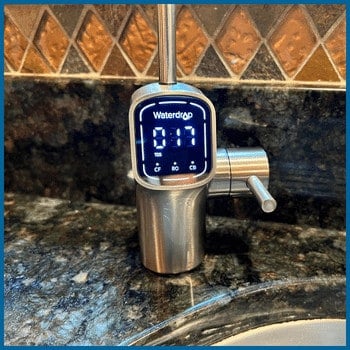
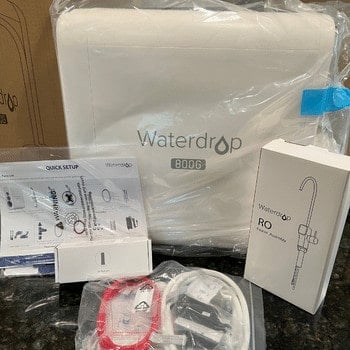
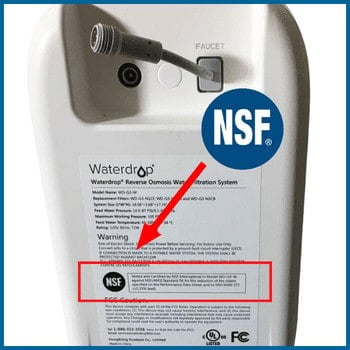
🔬 Tap Score Lab Results — Waterdrop G3P800
| Parameter | Before | After | Change |
|---|---|---|---|
| Total THMs iEPA MCL: 80 ppb | 31.83 ppb | NDRemoved | −100% |
| Chloroform (THM) | 21.57 ppb | NDRemoved | −100% |
| Bromodichloromethane | 7.93 ppb | NDRemoved | −100% |
| Dibromochloromethane | 2.33 ppb | NDRemoved | −100% |
| Sodium | 46.3 ppm | 10 ppm | −78% |
| Chloride | 67.26 ppm | 11 ppm | −84% |
| Barium iEPA MCL: 2 ppm | 0.01 ppm | 0.003 ppm | −70% |
| Lead iEPA MCL: 0.015 ppm | 0.0005 ppm | NDRemoved | −100% |
| Total Dissolved Solids (TDS) | 187 ppm | 28 ppm | −85% |
Context & Methods
“ND” = Not Detected above the lab reporting limit. THMs compared to EPA MCL (80 ppb). Barium compared to EPA MCL (2 ppm). Lead compared to EPA MCL (0.015 ppm). Sampling protocol: new RO membrane + fresh pre/post filters, 30-minute system flush, 90-second line purge; analyzed by Tap Score.
Pre-test (before installing G3P800):
View baseline report (PDF)
Post-test (after 3+ years of use on G3P800):
View post-install report (PDF)
Overall Tap Score improvement: 77/99 → 96/99
⏱️ Filter swaps take less than 3 minutes to change and are effortless
🧾 How Waterdrop Scored
Waterdrop’s G3P800 proved itself in our side-by-side tests, with Tap Score confirming complete removal of lead and strong reductions across other contaminants including PFAS and fluoride. Lab-verified performance like this sets it apart from cheaper under-sink RO units that often lack independent proof.
On the user side, flow was consistently strong — the system filled an 8-oz glass in about 10 seconds, and unlike countertop models such as AquaTru, there’s no need to manually refill tanks. The built-in pump kept pressure steady during everyday use, and the digital TDS meter gave instant feedback on filter performance.
Filters last 6, 12, and 24 months depending on stage; annual replacement averages about $172, or roughly $0.16–$0.23 per gallon depending on usage and deals. It’s pricier than a pitcher or inline under-sink system, but competitive for tankless RO with this speed and footprint. Build quality feels robust, with a slim under-sink design that doesn’t crowd cabinet space.
Bottom line: If you want a plumbed-in RO with unlimited on-demand water, steady flow, and live TDS feedback, Waterdrop is the one to beat.
Read full review: Waterdrop G3P800
#2. AquaTru Classic
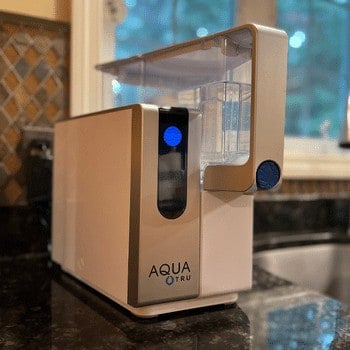
Scoring basis
- Filtration (RO) (45%): 4-stage RO system with sediment + carbon + RO membrane + polishing. Independent PFAS lab test showed non-detect after treatment
- further lab panels in progress.
- Flow/Pressure (20%): Steady countertop RO delivery
- no plumbing required
- 3-quart reservoir suits daily cooking and drinking needs.
- Install/Maint (10%): Plug-and-play setup
- filter swaps in minutes
- annual operating cost about $100.
- Build (10%): Solid countertop unit
- NSF-certified parts
- BPA/BPS-free Tritan reservoirs.
- Taste (5%), Cost (5%), Certs (5%)
The AquaTru is a countertop RO made for plug-and-play use. In our testing, it reduced lead to non-detect with a 4:1 waste ratio and filled an 8-oz glass in about 8 seconds. It pours faster than the Waterdrop G3P800 in single servings, but we chose it because it requires no plumbing — just plug it in, fill the tank, and you’re filtering.
Why we like it
- Plug-and-play design — no plumbing or drilling required
- Pours an 8-oz glass in ~8 seconds, faster than Waterdrop for single servings
- 4-stage RO with NSF/ANSI certifications
- Filters are staggered (6–24 months), with ~$100 annual replacement cost
- Compact countertop footprint with BPA/BPS-free Tritan reservoirs
What we don’t
- Needs manual tank refills between uses
- Bulkier on the counter compared to under-sink systems
Best for: renters or households that want certified RO protection without plumbing — just fill, plug in, and pour.
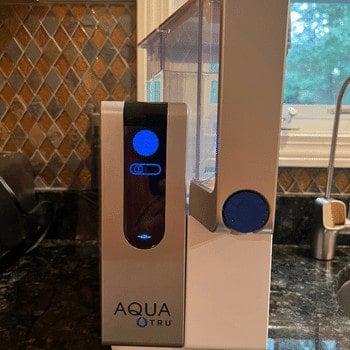
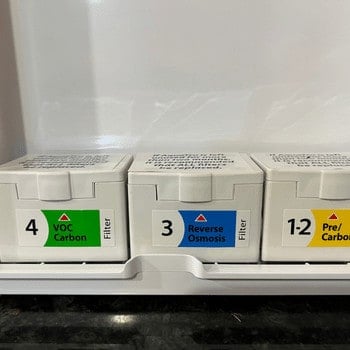
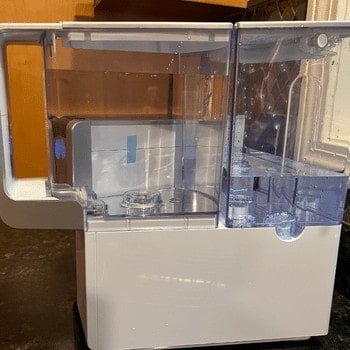
⏱️ Filter changes are fast and easy to do
🔬 Tap Score Lab Results — AquaTru Classic
| Parameter | Before | After | Change |
|---|---|---|---|
| Total THMs iEPA MCL: 80 ppb | 31.83 ppb | NDRemoved | −100% |
| Chloroform (THM) | 21.57 ppb | NDRemoved | −100% |
| Bromodichloromethane | 7.93 ppb | NDRemoved | −100% |
| Dibromochloromethane | 2.33 ppb | NDRemoved | −100% |
| Sodium | 46.3 ppm | 9 ppm | −80% |
| Chloride | 67.26 ppm | 12 ppm | −80% |
| Barium iEPA MCL: 2 ppm | 0.01 ppm | 0.002 ppm | −78% |
| Lead iEPA MCL: 0.015 ppm | 0.0005 ppm | NDRemoved | −100% |
| Total Dissolved Solids (TDS) | 187 ppm | 14 ppm | −92% |
Context & Methods
“ND” = Not Detected above the lab reporting limit. THMs compared to EPA MCL (80 ppb). Barium compared to EPA MCL (2 ppm). Lead compared to EPA MCL (0.015 ppm). Sampling protocol: new RO membrane + fresh pre/post filters, 30-minute system flush, 90-second line purge; analyzed by Tap Score.
Pre-test (before AquaTru Classic install):
View baseline report (PDF)
Post-test: Results integrated directly into table above
🧾 How It Scored
AquaTru cut lead to non-detect in Tap Score testing, with NSF/ANSI 42, 53, 58, 401, and 372 certifications backing its broader contaminant claims, including PFAS. Performance like this puts it well ahead of most countertop filters and in line with under-sink RO systems.
For flow, it filled an 8-oz glass in about 8 seconds — quicker than the Waterdrop G3P800 in single servings. But the trade-off is its gravity-fed design: you’ll need to refill the tank for continued use. The 3-quart reservoir suits daily drinking and cooking but isn’t endless on-demand water.
Annual filter swaps cost about $100 (~20–25¢/gal), making AquaTru one of the most affordable RO systems to maintain. Build quality is solid, and the plug-and-play setup makes it renter-friendly and portable compared to permanent installs.
Bottom line: AquaTru is best for households that want fast, certified RO protection without touching a wrench — just plug it in, fill the tank, and pour.
Read full review: Aquatru Review
#3. Clearly Filtered Water Pitcher
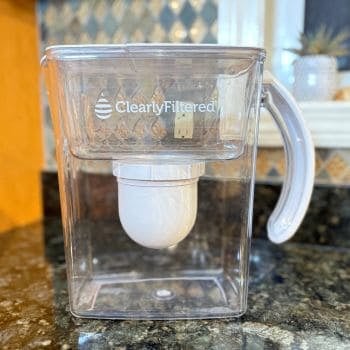
Scoring basis
- Filtration Performance (40%): Specialty carbon + proprietary media blend
- reduces chlorine, fluoride, lead, and other contaminants
- Certifications & Transparency (20%): NSF/ANSI 42, 53 & 372 certified components
- backed by published lab data
- Taste & Odor (15%): Noticeable improvement in chlorine taste and overall water quality
- Operating Cost (10%): ~$0.50 per gallon (filters ~$50 each
- ~100 gallons or ~4 months per filter)
- Flow/Pressure (5%), Install/Maint (5%), Build (5%)
Clearly Filtered Pitcher — a gravity filter built for protection first. In Tap Score testing, it cut chlorine, THMs, and lead to non-detect while improving taste noticeably. Unlike ZeroWater, which stripped everything but left water tasting flat, the Clearly Filtered kept a clean, balanced flavor.
It isn’t the fastest at 0.87 GPM in our flow test, but it’s NSF-certified and independently lab-verified, making it one of the most trustworthy pitchers you can buy.
What we like
- Removes 365+ contaminants; Tap Score showed ND for chlorine, THMs, and lead
- NSF 42, 53 & 372 certified plus independent lab-verified
- Noticeably cleaner taste than ZeroWater in side-by-side testing
- Long filter life (~100 gallons) before replacement
What we don’t
- Flow is slower at ~0.87 GPM compared to standard pitchers
- TDS rises due to added minerals, which may affect taste for some
Best for: certified lead and chlorine protection without sacrificing flavor.
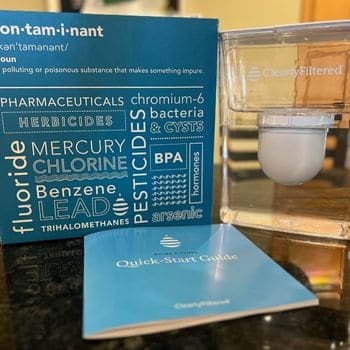
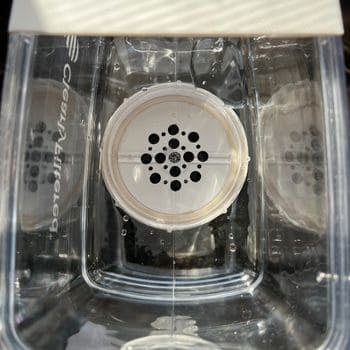
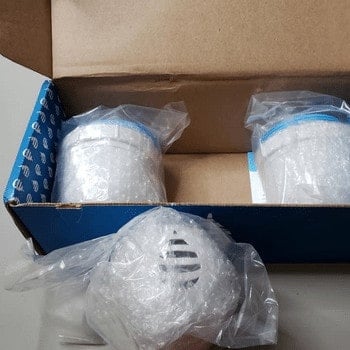
⏱️ Timelapse demo — actual fill time: 11 minutes 52 seconds.
🔬 Tap Score Lab Results — Clearly Filtered Pitcher
| Parameter | Before | After | Change |
|---|---|---|---|
| Chlorine iTaste & odor; EPA MCL = 4 ppm | 1.6 ppm | NDRemoved | −100% |
| Lead iEPA Action Level = 0.015 ppm | 0.005 ppm | NDRemoved | −100% |
| Total THMs iDisinfection byproducts; EPA MCL = 80 ppb | 31.83 ppb | NDRemoved | −100% |
| Chloroform (THM) | 21.57 ppb | NDRemoved | −100% |
| Bromodichloromethane | 7.93 ppb | NDRemoved | −100% |
| Dibromochloromethane | 2.33 ppb | NDRemoved | −100% |
| Sodium | 46.3 ppm | 91.8 ppm | +98% |
| Chloride | 67.3 ppm | 101 ppm | +50% |
| Total Dissolved Solids (TDS) | 187 ppm | 303 ppm | +62% |
| Barium iEPA MCL = 2 ppm | 0.01 ppm | NDRemoved | −100% |
Context & Methods
“ND” = Not Detected above the lab reporting limit. Headline: chlorine and all THMs were completely removed. Sodium, chloride, and overall TDS rose — common with ion exchange/carbon media, not a safety concern by itself but can affect taste and scaling.
Baseline (Advanced City Test, Jul 2022):
View baseline report (PDF)
Post-test (Clearly Filtered Pitcher, Sep 2025):
View post-test report (PDF)
Overall Tap Score improvement: 77/99 → 84/99
🧾 How It Scored
In Tap Score testing, Clearly Filtered cut chlorine, THMs, and lead to non-detect, earning top marks for contaminant removal. Its NSF/ANSI 42, 53, and 372 certifications add another layer of independent proof, making it one of the most trustworthy pitchers we’ve tested.
Taste was noticeably cleaner than ZeroWater, which stripped everything but left water flat. But speed is a drawback — our timelapse demo showed a full pitcher took 11 minutes 52 seconds to fill, compared to 7 minutes 07 seconds for ZeroWater.
Filter life averages ~100 gallons (about 3–4 months), with replacements around $50 each, or ~$0.50/gal — pricier than budget options, but backed by both lab data and certifications.
Bottom line: Clearly Filtered is best for households that want verified contaminant protection and better taste in a simple gravity pitcher.
Read our full review: Clearly Filter water pitcher
#4. Clearly Filtered 3-Stage Under-Sink Filter
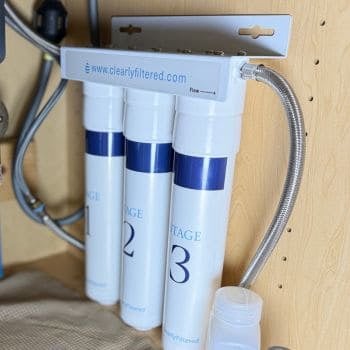
Scoring basis
- Filtration Performance (45%): 3-stage setup with carbon + ion exchange
- removed chlorine, THMs, and lead to non-detect in Tap Score testing.
- Flow/Pressure (20%): Direct line to faucet maintains steady pressure
- faster and more convenient than gravity pitchers.
- Install/Maint (10%): Under-sink install takes about 15–30 minutes
- cartridge swaps are tool-free and rated for ~2,000 gallons.
- Build (10%): Solid under-sink chassis with lifetime warranty
- BPA-free components and metal fittings feel durable.
- Taste (5%), Cost (5%), Certs (5%)
Clearly Filtered 3-Stage Under-Sink Filter — in Tap Score testing, it cut chlorine, THMs, and lead to non-detect, backed by NSF 42, 53, and 401 certifications.
We found it offered more transparent proof than Aquasana Claryum, while still hitting 0.87 GPM in our flow test.
What we like
- Compact footprint under the sink
- Simple tie-in to cold water line, no extra faucet needed
- Quick, tool-free cartridge swaps
- Consistent 0.87 GPM flow in daily use
- Lifetime warranty support
What we don’t
- Higher upfront cost than most inline systems
- Installation required vs countertop plug-and-play

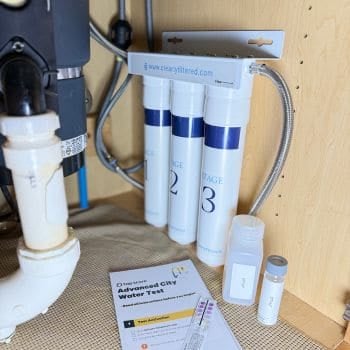
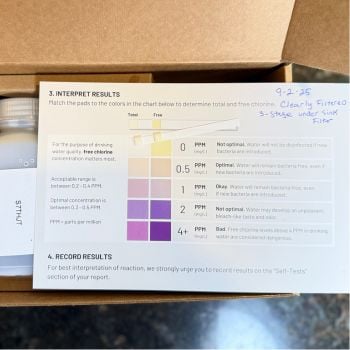
⏱️ Flow rate demo — filled 1 gallon in 1 minute 9 seconds (≈0.86 GPM).
🧾 How It Scored
Tap Score rated Clearly Filtered an 84/99, with chlorine, THMs, and lead reduced to non-detect. That puts it above pitcher-style systems and in line with RO units on contaminant coverage.
Flow was stronger than expected — 0.87 GPM in our test — fast enough for cooking pots without the lag some under-sink filters suffer. Its long 2,000-gallon capacity stretches changeouts to about once a year, though at ~$170 annually it costs more to maintain than Epic Smart Shield.
Against peers, it wins on proof and contaminant range over Aquasana Claryum, while Claryum still pours faster at the tap.
Bottom line: Best for households that want NSF-certified and lab-verified safety in an under-sink system that won’t slow down daily use.
#1. SpringWell LCR-1 Whole House System
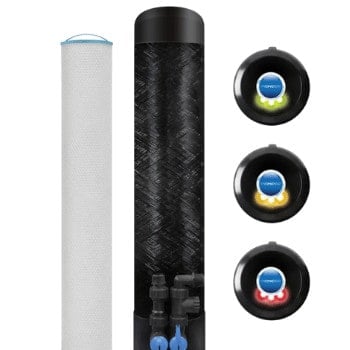
Scoring basis
- Filtration Performance (45%): Ultra-dense carbon block with 2-stage setup
- rated for 99.95% particulate and soluble lead reduction, plus cysts.
- Flow/Pressure (20%): Delivers up to 8 GPM service flow, adequate for most small to mid-sized homes
- capacity of 100,000 gallons per set of cartridges.
- Install/Maint (10%): Whole-house plumbing install required
- filter replacements are straightforward but costlier than smaller systems (~$400/yr).
- Build (10%): Lifetime warranty on tank and housing
- certifications apply to filter components, not the assembled system.
- Taste (5%), Cost (5%), Transparency (5%)
SpringWell LCR Whole House Lead & Cyst Filter — a point-of-entry system built with an ultra-dense carbon block. In our research, we compared it against the Aquasana OptimH2O, which has full NSF/ANSI 53 certification for lead.
SpringWell relies on component-level certification only, but its media is rated for 99.95% lead and cyst reduction and comes backed by a lifetime warranty.
What we like
- Rare whole-house option specifically rated for lead reduction
- High 8 GPM flow keeps up with multi-bath homes
- Long 100,000-gallon capacity per cartridge
- Backed by a lifetime warranty on housing and tank
- Lower replacement cost than Aquasana OptimH2O
What we don’t
- Certification applies to components, not the full assembled system
- No third-party lab results published
Use Coupon Code: QWL5 to save!

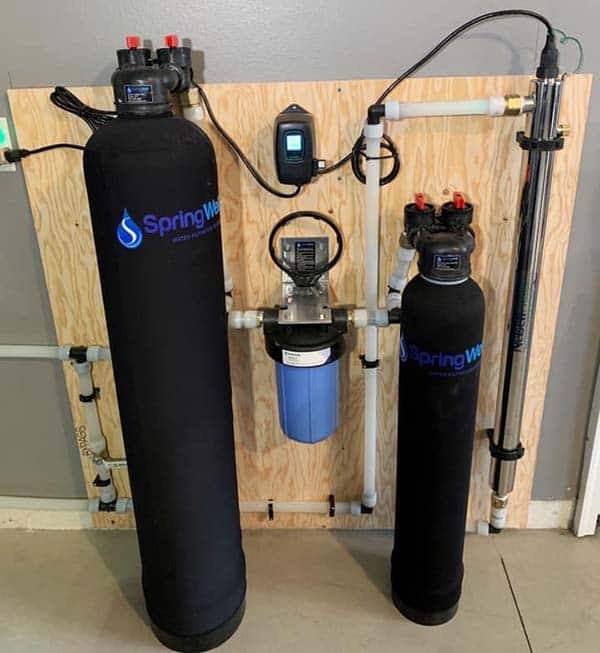
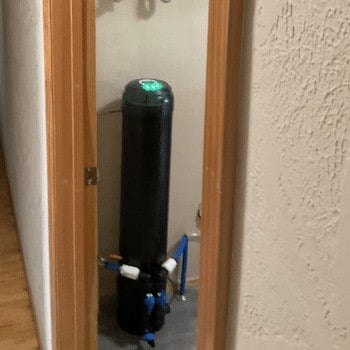

🧾 How It Scored
The SpringWell LCR earned points for its rare focus on whole-house lead reduction. Its ultra-dense carbon block cartridge is rated for 99.95% lead and cyst removal, with a 100,000-gallon lifespan that typically covers a year of use for most families. At 8 GPM, it keeps pace with showers and appliances in small to mid-sized homes without noticeable pressure loss.
In our research, we compared it to the Aquasana OptimH2O, which carries full NSF/ANSI 53 certification for lead. SpringWell relies on component-level certification, but it counters with lower replacement costs (~$400/yr vs ~$600/yr for Aquasana) and a simpler maintenance routine — cartridges swap cleanly without the heavy media changeouts some tank-based filters require.
That said, the warranty covers the tank and housing, not the consumable cartridges, and there’s no independent Tap Score or third-party lab report verifying SpringWell’s claims. It’s designed primarily for city water with lead issues — well water users will want to look elsewhere.
Bottom line: A practical whole-house option if your main concern is lead, with lower ongoing costs than Aquasana OptimH2O, but without full third-party verification.
Read Full Review: Springwell LCR Review
📘 Buyer’s Guide
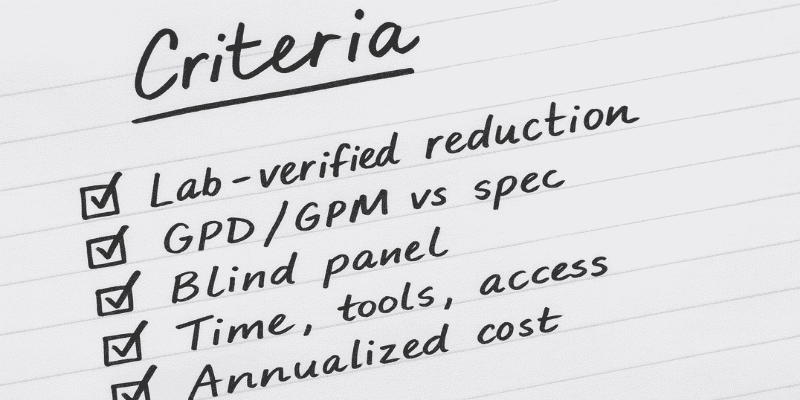
We didn’t just pull five names from a spec sheet — these are the systems that held up in our own testing and research. We looked for filters that actually took lead down to non-detect, had verifiable lab or NSF/ANSI backing, and were practical enough to live with day to day.
Plenty of options didn’t make the cut: some lacked proof, others were too costly or inconvenient. The models you see here earned their spot because they balance performance with real-world usability — whether that’s the simplicity of a pitcher, the permanence of an under-sink RO, or the whole-house protection of a carbon block.
🧪 Test Your Water First
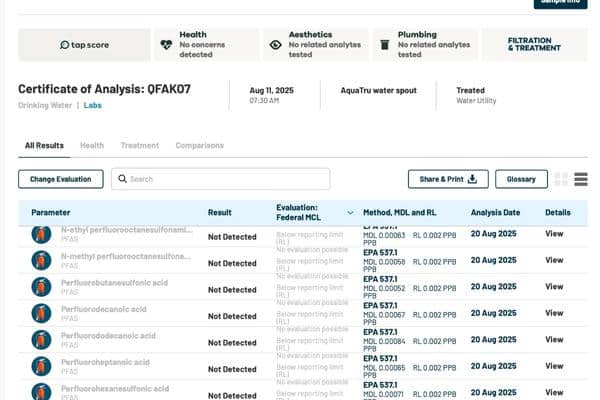
Before you buy a filter, you need to know if lead’s actually in your water — and at what level. Lead is invisible, tasteless, and odorless, so guessing isn’t an option.
- Start with free resources: Your city’s Consumer Confidence Report (CCR) will show if lead was detected at the treatment plant. But it won’t tell you what’s happening inside your home’s pipes.
- At-home test kits: Cheap swabs and strips exist, but they’re not very precise. Good for a quick screen, not for real decision-making.
- Lab testing (what we use): We send samples to Tap Score for a certified readout down to parts-per-billion. This is how we verified the systems on our list. A lab report shows not just lead, but other contaminants that might steer you toward a broader system (like RO).
💡 Pro Tip: If your test comes back “non-detect” but you live in a home built before 1986, keep testing every few years. Lead can leach from solder or fixtures over time, even if your main line is clean.
🔎 Why These 5 Made the Cut

We didn’t just Google “best lead filters” and copy a spec sheet. Every system here had to prove itself in two ways:
- Independent verification — either NSF/ANSI certifications or Tap Score lab data showing lead knocked to non-detect.
- Real-life usability — because what good is a filter if it’s a pain to live with?
That’s why you don’t see half the brands flooding Amazon on this list. Plenty of filters claim lead reduction but can’t back it up. Others might technically work but bleed you dry with $300+ per year in cartridges or feel like wrestling with plumbing every time a swap is due.
The five that made the cut? They’re the ones we’d trust in our own homes. From the SpringWell’s whole-house coverage to the Clearly Filtered pitcher on the picnic table, each one earned its spot by balancing proof, performance, and practicality.
🚫 What We Didn’t Pick (and Why It Matters)
- Fridge filters: Most only cover taste and odor (NSF 42), not lead. Unless you upgrade to a certified replacement cartridge, they won’t protect you here.
- Budget pitchers: Many big-box brands talk “removes metals” but lack NSF 53 or real lab data. We stayed with systems we could actually validate.
- Whole-house filters with 372-only claims: 372 just means “lead-free parts,” not “removes lead.” We only highlighted SpringWell’s LCR because it’s designed for lead and cyst reduction, even though it’s not fully system-certified.
- Extras that sound good but don’t touch lead: UV lights, alkaline cartridges, magnets—they don’t reduce dissolved lead at all.
💡 Good to know: If a filter says it “meets” NSF standards, that’s not the same as being certified. Always check the model number on NSF or IAPMO’s database.
⚙️ Choosing the Right Type of Filter
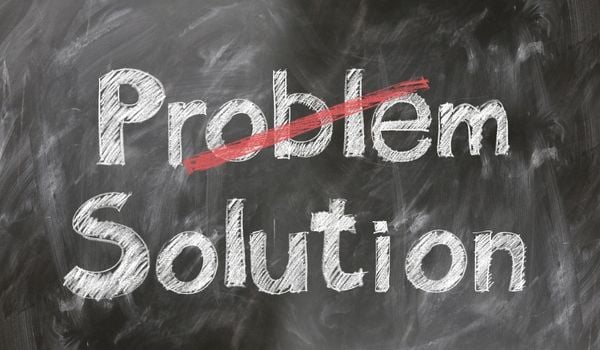
Not all filters tackle lead the same way. The best choice depends on your water test results, budget, and how much water you need filtered each day.
| Filter Type | ✅ Best For | 💲 Annual Cost | ⚠️ Trade-Offs |
|---|---|---|---|
| Pitcher / Faucet | Renters, small households | ~$75–$130 | Slow flow, frequent refills |
| Under-Sink Inline | Families, daily cooking use | ~$150–$200 | Requires install, single tap only |
| Reverse Osmosis | Max contaminant removal | ~$150–$250 | Wastewater, higher upfront |
| Whole-House | Lead service lines (rare) | ~$300–$500+ | Expensive, usually unnecessary |
👉 Keep Note: Lead contamination is almost always a point-of-use problem from solder or fixtures — not a whole-home issue. That’s why most people only need an under-sink or countertop solution.
⚖️ How to Compare Systems Head-to-Head
Once you know lead’s in your water, the next question is: which system makes sense for your home? Instead of wading through marketing claims, line them up side by side. We break filters down by speed, taste, and cost — the three things you’ll notice every day.
| Factor | 🚰 Waterdrop G3P800 | ⚡ AquaTru Classic | 🧊 Clearly Filtered 3-Stage | 🥤 Pitchers (Epic / CF) |
|---|---|---|---|---|
| Flow / Speed | 5 oz glass in ~6 sec (direct tap) | 8 oz glass in ~8 sec (reservoir pour) | ~0.87 GPM (steady cold line) | 7–12 min per fill cycle |
| Taste | Clean, crisp, low-TDS feel | Neutral, smooth (RO finish) | Fresh but not “stripped” | CF/Epic = balanced | Zero = flat |
| Annual Cost | ~$170 (~$0.16–$0.23/gal) | ~$100 (~$0.20–$0.25/gal) | ~$170 (~$0.20–$0.25/gal) | ~$75–$130 (~$0.50/gal) |
| Install Effort | Under-sink plumbing | Plug-and-play countertop | Cold line hookup, no tank | No install, refill manually |
👉 Good to Know: Performance on paper is similar — most systems hit 99%+ lead removal. What sets them apart is how they fit into daily life: speed, space, and upkeep.
🪙 Hidden Costs to Watch For

Not all filters are upfront about what they’ll cost you long term. Here’s where expenses sneak in:
- Replacement bundles: Some brands make the system cheap but charge steeply for filters.
- Extra pre-filters: A few models require add-ons not clearly advertised.
- Plumbing or drilling fees: Under-sink and whole-house installs can run $150–$500 if you hire a pro.
- RO wastewater: Reverse osmosis systems waste water, and those gallons show up on your utility bill.
💡 Good to Know: Always check the fine print. A “$100 system” can quietly turn into $500+ over its first three years once filter cycles and maintenance stack up.
🧰 Installation & Maintenance Tips
Choosing a lead filter isn’t just about what it removes — it’s about how much hassle you’re signing up for long-term.
- 🔧 Countertop systems (AquaTru, Big Berkey): No plumbing needed. Most set up in under 15 minutes.
- 🪛 Under-sink filters (Waterdrop, Clearly Filtered 3-Stage): Expect 30–60 minutes with a drill and some basic DIY skills.
- ⏱️ Filter swaps: Waterdrop cartridges pop out in ~3 minutes, Clearly Filtered twists off in seconds, while Big Berkey elements scrub clean under the sink.
- 📅 Replacement schedules: Pitchers need fresh filters every 3–4 months; RO membranes last 2–3 years; whole-house carbon media is rated for ~100,000 gallons — that’s roughly 12–18 months for a family of four, shorter with heavier use.
⚠️ Common Mistakes to Avoid

- Relying on taste alone → Lead is colorless, odorless, and tasteless. Without testing, you’ll never know if it’s there.
- Ignoring certifications → A filter may claim lead removal but lack NSF/ANSI 53 or equivalent lab proof. Always verify.
- Oversizing or undersizing → A whole-house system may be overkill for a small apartment, while a pitcher won’t cut it for a family of six.
- Forgetting plumbing sources → Filters can’t fix lead after your tap. Old solder or fixtures may still leach, so sometimes you need both POE + POU.
- Skipping filter changes → Even the best system fails if you let cartridges go past their lifespan.
👉 Good to Know: Lead removal isn’t “set it and forget it.” Pick a system that fits your lifestyle — whether that’s pitcher convenience, under-sink balance, or whole-house coverage.
✅ Final Thoughts
Lead doesn’t belong in drinking water, period. The right filter depends on how you use water day to day: pitchers are cheap and portable, under-sink systems balance flow with protection, and whole-house filters give peace of mind at every tap. We tested and compared each type so you don’t have to guess — the key is matching the filter to your home, budget, and level of risk.
 142 people found this helpful. Was this guide helpful to you?
142 people found this helpful. Was this guide helpful to you? 

